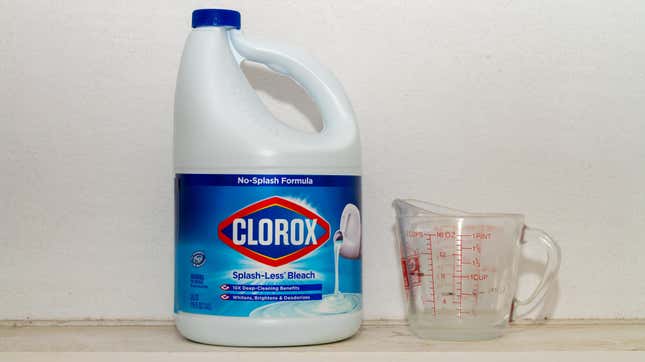
Bleachhas a ton of uses outside oflifting stainsfromwhite clothes,but there are some dos and don’ts we should all remember。你已经知道不要混合漂白with any other cleaners or disinfectants, as it can release dangerousvapors, but there’s more thatyou should avoid.
What you can use bleach on
According to Architectural Digest, bleach can kill bacteria and pathogens left on surfaces after an initial cleaning. It’s not a cleaner itself, but works within 10 to 60 minutes of contact to kill what’sleft behind after your first run-through with soap and water or another cleaning agent.
What you shouldn’t use bleach on
That said, there are some surfaces you shouldnotbleach down:
- Laminate
- Stone
- Marble
- Granite
- Quartz
- Aluminum
- Silver
- Copper
- Enamel (with chips in it)
- Anything electronic
The reasons for avoiding bleachvary:For instance, bleach can eat away at the protective coating on laminate and damage the laminate paper beneath,or bleachcaneat away the sealants on stone countertops,discoloring them. Basically, it’s too corrosive to be trusted on certain surfaces, but it’s fine on glazed ceramics, plastic cutting boards, painted wood, and the like. Since you need to leave bleach on surfaces for a while to really disinfect them, you can guesshow thiserosion might bea problem.
You also shouldn’t try to clean grout with bleach, although you may read recommendations elsewhere that you should. Since groutso porous, bleach can really fade and erode it.
Dilute your bleach, but never with hot water
You may have heardthatbleach shouldbe diluted, but you may not knowhow much。According to the Centers for Disease Control and Prevention, you should first follow the instructions on the bottle you have, but if it doesn’t have instructions, use ⅓ cup of bleach per gallon of room-temperature water or four teaspoons per quart of room-temp water.Never dilute bleach with hot water, as this can allow some bleach to waft into the air with the steam, irritating your eyes and nose. Plus, hot water breaks down the bleach’s chemicals more quickly.
Even when diluting it just right, you should use bleach in rooms with good ventilation to avoid breathing the stuff in。Open your windows and doors.Wear gloves and protective materials, too, as well as old clothes you wouldn’t mind gettinga bleach stain. (You can alwaysturn them into cool tie-dyeafter a mishap, though。)
